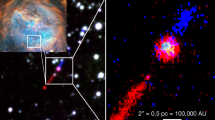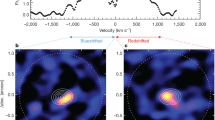Abstract
A star forms when a cloud of dust and gas collapses. It is generally believed that this collapse first produces a flattened rotating disk1,2, through which matter is fed onto the embryonic star at the centre of the disk. When the temperature and density at the centre of the star pass a critical threshold, thermonuclear fusion begins. The remaining disk, which can still contain up to 0.3 times the mass of the star3,4,5, is then sculpted and eventually dissipated by the radiation and wind from the newborn star. But this picture of the structure and evolution of the disk remains speculative because of the lack of morphological data of sufficient resolution and uncertainties regarding the underlying physical processes. Here we present images of a young star, LkHα101, in which the structure of the inner accretion disk is resolved. We find that the disk is almost face-on, with a central gap (or cavity) and a hot inner edge. The cavity is bigger than previous theoretical predictions6, and we infer that the position of the inner edge is probably determined by sublimation of dust grains by direct stellar radiation, rather than by disk-reprocessing or viscous-heating processes as usually assumed29.
This is a preview of subscription content, access via your institution
Access options
Subscribe to this journal
Receive 51 print issues and online access
$199.00 per year
only $3.90 per issue
Buy this article
- Purchase on Springer Link
- Instant access to full article PDF
Prices may be subject to local taxes which are calculated during checkout

Similar content being viewed by others
References
Terebey, S., Shu, F. H. & Cassen, P. The collapse of the cores of slowly rotating isothermal clouds. Astrophys. J. 286, 529–551 (1984).
Yorke, H. W., Bodenheimer, P. & Laughlin, G. The formation of protostellar disks. 2: Disks around intermediate-mass stars. Astrophys. J. 443, 199–208 (1995).
Cassen, P. M., Smith, B. F., Miller, R. H. & Reynolds, R. T. Numerical experiments on the stability of preplanetary disks. Icarus 48, 377–392 (1981).
Shu, F. H., Tremaine, S., Adams, F. C. & Ruden, S. P. Sling amplification and eccentric gravitational instabilities in gaseous disks. Astrophys. J. 358, 495–514 (1990).
Hollenbach, D., Johnstone, D., Lizano, S. & Shu, F. Photoevaporation of disks around massive stars and application to ultracompact H II regions. Astrophys. J. 428, 654–669 (1994).
Hillenbrand, L. A., Strom, S. E., Vrba, F. J. & Keene, J. Herbig Ae/Be stars—Intermediate-mass stars surrounded by massive circumstellar accretion disks. Astrophys. J. 397, 613–643 (1992).
Kessel, O., Yorke, H. W. & Richling, S. Photoevaporation of protostellar disks. III. The appearance of photoevaporating disks around young intermediate mass stars. Astron. Astrophys. 337, 832–846 (1998).
Hartmann, L., Kenyon, S. J. & Calvet, N. The excess infrared emission of Herbig Ae/Be stars—Disks or envelopes? Astrophys. J. 407, 219–231 (1993).
Böhm, T. & Catala, C. Forbidden lines in Herbig Ae/Be stars: the [O I](1F) 6300.31Å and 6363.79Å lines. I. Observations and qualitative analysis. Astron. Astrophys. 290, 167–175 (1994).
Miroshnichenko, A., Ivezic, Z. & Elitzur, M. On protostellar disks in Herbig Ae/Be stars. Astrophys. J. 475, L41–L44 (1997).
Pezzuto, S., Strafella, F. & Lorenzetti, D. On the circumstellar matter distribution around Herbig Ae/Be stars. Astrophys. J. 485, 290–307 (1997).
Miroshnichenko, A., Ivezic, Z., Vinkovic, D. & Elitzur, M. Dust emission from Herbig Ae/Be stars: evidence for disks and envelopes. Astrophys. J. 529, L115–L118 (1999).
Barsony, M., Scoville, N. Z., Schombert, J. M. & Claussen, M. J. The circumstellar environment of the emission-line star LkH-alpha 101. Astrophys. J. 362, 674–690 (1990).
Hou, J., Jiang, D. & Fu, C. Physical properties of stellar winds from young stellar objects. Astron. Astrophys. 327, 725–735 (1997).
Tuthill, P. G., Monnier, J. D., Danchi, W. C., Wishnow, E. H. & Haniff, C. A. Michelson interferometry with the Keck I telescope. Publ. Astron. Soc. Pacif. 112, 555–565 (2000).
Barsony, M., Schombert, J. M. & Kis-Halas, K. The LkH-alpha 101 infrared cluster. Astrophys. J. 379, 221–231 (1991).
Herbig, G. H. The spectrum of LkHα 101 in the near-infrared. Astrophys. J. 169, 537–541 (1971).
Stine, P. C. & O'Neal, D. Radio emission from young stellar objects near LkHα 101. Astron. J. 116, 890–894 (1998).
Harris, S. 5 GHz radio observations of LkHα 101, M1-82#1 and other infrared sources. Mon. Not. R. Astron. Soc. 174, 601–607 (1976).
Cohen, M., Bieging, J. H. & Schwartz, P. R. VLA observations of mass loss from T Tauri stars. Astrophys. J. 253, 707–715 (1982).
Panagia, N. Some physical parameters of early-type stars. Astron. J. 78, 929–934 (1973).
Millan-Gabet, R. et al. Sub-astronomical unit structure of the near-infrared emission from AB Aurigae. Astrophys. J. 513, L131–L134 (1999).
Millan-Gabet, R., Schloerb, F. P. & Traub, W. A. Spatially resolved circumstellar structure of Herbig Ae/Be stars in the near-infrared. Astrophys. J. 546, 358–381 (2001).
Akeson, R. L. et al. Infrared interferometric observations of young stellar objects. Astrophys. J. 543, 313–317 (2000).
Gull, S. F. & Skilling, J. Maximum entropy method in image processing. IEE Proc. F 131, 646–650 (1984).
Sivia, D. S. Phase Extension Methods. Thesis, Cambridge Univ. (1987).
Tuthill, P. G., Monnier, J. D. & Danchi, W. C. A dusty pinwheel nebula around the massive star WR 104. Nature 398, 487 (1999).
Tuthill, P. G., Monnier, J. D., Danchi, W. C. & Lopez, B. Smoke signals from IRC + 10216: 1. Milliarcsecond proper motions of the dust. Astrophys. J. 543, 284 (2000).
Lynden-Bell, D. & Pringle, J. E. The evolution of viscous discs and the origin of the nebular variables. Mon. Not. R. Astron. Soc. 168, 603–637 (1974).
Acknowledgements
We would like to thank D. Sivia for the maximum-entropy mapping program VLBMEM. Data were obtained at the W.M. Keck Observatory, made possible by the generous support of the W.M. Keck Foundation, operated as a scientific partnership among the California Institute of Technology, the University of California and NASA. This work was supported through grants from the National Science Foundation.
Author information
Authors and Affiliations
Corresponding author
Rights and permissions
About this article
Cite this article
Tuthill, P., Monnier, J. & Danchi, W. A dusty torus around the luminous young star LkHα101. Nature 409, 1012–1014 (2001). https://doi.org/10.1038/35059014
Received:
Accepted:
Issue Date:
DOI: https://doi.org/10.1038/35059014
This article is cited by
-
Herbig Stars
Space Science Reviews (2023)
-
Radiation-driven acceleration in the expanding WR140 dust shell
Nature (2022)
-
UV spectropolarimetry with Polstar: protoplanetary disks
Astrophysics and Space Science (2022)
-
Accretion disks in luminous young stellar objects
The Astronomy and Astrophysics Review (2016)
-
Formation and evolution of planetary systems: the impact of high-angular resolution optical techniques
The Astronomy and Astrophysics Review (2010)
Comments
By submitting a comment you agree to abide by our Terms and Community Guidelines. If you find something abusive or that does not comply with our terms or guidelines please flag it as inappropriate.



